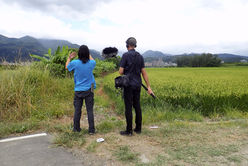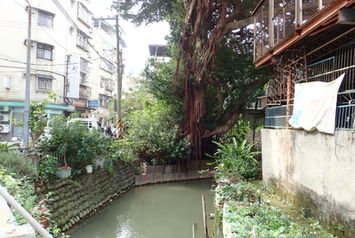
蔡宛璇&
澎葉生
TSAI WAN SHUEN & YANNICK DAUBY
scroll
|聲音與環境|
澎葉生(Yannick Dauby)是定居臺灣的法籍聲音藝術與錄音工作者。遊走於自然、 都會、鄉間和工業環境間多年的聆聽經驗,並延展出各類形式的聲音創作實踐。
蔡宛璇,造型藝術工作者與詩書寫。出生澎湖,旅法數年,現定居臺北盆地邊緣。
跨域採集研究概念
The Concept of Interdisciplinary Collecting Research
我們是否確定我們生活在適當的環境?基本的檢驗方法有很多,像是生活必須的空氣品質分析,也可以輕易地聯想到教育、交通等等的領域。但是關於適切棲地的考量因素,有些是較容易被人們忽略的。
我建議以聆聽作為一種方法來探查都市區域的幽微面向,像是一位聽診的醫生聽身 體所說的話,人可以聽到城市的表達。這不僅是關乎噪音干擾,同時是在檢驗居民 們如何與他們的環境產生關聯。非人類生命和水的存在暗示著城市內部的共生生態系統,而具有歷史意義的聲音可以幫助我們根植自己,進一步認同社群。基礎建設發出的聲音,就算沒有形成巨大的背景噪音,也揭示了城市的脈搏和呼吸。
空總可以作為此種探究的基礎:將臺北盆地不同區域提取的聲音整合成可以聆聽的形式,供觀眾觸及。這同時也是一個發展聆聽社群的機會,用以增加對聲音環境的關注。這些年來,許多行動或計畫都提到了「音景」的概念,但臺灣一直還沒有一個發展我們聲音文化的平台,一個準備好向公眾發聲的具體場所,透過像是田野錄音 和聲音紀錄創作的方式發聲。 我認為空總這樣一個聲音基地,可以是個探索聆聽實 踐的中心和輻散點。
舉例來說,我所發展的近期作品與北投地區有關。為什麼選擇北投?是因為它呈現 出各種各樣的聲音元素,將生活在那裡的人融入歷史中(從傳統市場到打石),這樣 的特質源自該地區的農業,與人類移居和交通有關,甚至可以將人放在更大規模的地質活動上來看待。
Are we sure our living environment is appropriate ? There are many fundamental ways of checking it, just think about the chemical analysis of the air, which is mandatory for our health. We can also easily think about access to education, to transportation, etc. But there are other factors for a suitable habitat which are maybe less considered.
I would propose listening as a way to investigate these subtle aspects of the urban area. Like a doctor who is auscultating, listening to what the body says, one can listen what the city is expressing. It is not only a matter of noise disturbance but also to check if the inhabitants can relate to their environment. Presence of non-humans, of water can gives hint about cohabiting ecosystems inside the city. Sounds that have a historical significance can helps us root ourselves, identify with the communities. Sounds that emanate from infrastructures, if they don't contribute to the massive background noise, can also reveal the pulse and the breaths of the city.
Kong-Zong (TAF/C-Lab) could be a base for this type of investigations: sounds extracted from different areas of the Taipei Basin could be integrated into an audible form, accessible to audience. This is also an opportunity to develop a listening community, to increase the attention towards sound environment. These last years, numerous actions or projects are referring to the concept of “soundscape”, but there is not yet a platform for developing our audio culture, a physical place for listening what has been already prepared for the public, such as field recordings and audio documentaries. This audio base in Kong-Zong could be a centre for exploring listening practices.
As an example, I am presenting my most recent work, related to Beitou area. Why Beitou? Because it presents a large variety of sound elements that integrate the human beings living there into the History (from the traditional market to the stone carving), that emanate from the agricultural aspect of the area, that relate to human displacement and transportation, and even place human on a much larger scale, the geological activity.
跨域採集研究講座節選
The Talk Excerpt of Interdisciplinary Collecting Research
剛開始來到空總的時候,我們去思考它的聲音到底是什麼?第一個是空總周邊的城 市背景聲音,以及在不同建築空間裡頭行走時產生的特殊音場。但是從聲音的角度 去聆聽,空總缺乏多層次的、和人與物之間的互動關係,因為過去這裡不是有機形成的生活空間,現在又是一個低度使用的地方,我們認為在分享和再現有一定難度,因為這樣細緻的空間需要特殊條件的聲音再現系統,但是在臺灣缺乏這樣的場域。
後來把採集場域拉到北投,因為我們覺得北投非常適合透過採集工作,去看臺北 的開發史、人跟自然長期互動的都市紋理。我們以聲音做為採集媒介,在不同的 環境紀錄聲音,以及透過人物訪錄,增加時間軸上多層次的闡述跟詮釋。我們把採集計畫分成兩個段落,第一個我們試著去討論風景是什麼?第二個是關於北投 大屯山系的地質,和地質對當地居民產生的經濟活動、建築風景和水文的影響。 還有與林暐翔合作的關渡平原聲音採集,去了解從山系、水文、農業、環境變遷的關係以及捷運系統穿越北投後,如何改變人們在空間上的感知。
從聲學的角度來看,城市裡充斥著太多的聲音,在臺北的交通噪音無所不在,住 在這個環境久了我們對聲音的敏感度會降低。從事與聲音相關的領域,其實是一 個很好的方式讓我們練習傾聽的能力。例如在歐洲的一個聲音平台,法國與德國合作的電視台ARTE Radio。2000年的時候,他們啟動了一個網路電台,組織一群有相關經驗的成員,很有趣的是它所有節目都是經過策展。它收錄很多聲音檔 案,同時也是聲音的資料庫。他們也有一個實體的工作室,提供技術上的支援, 提供空間讓人可以相互交流。此外也有人才培訓的課程,截至為止已經累積了超過三百多位的創作者。對創作者而言,ARTE Radio有提供補助金,它所延伸的聲音創作社群也刺激了更多不同的創作型態,譬如音樂、聲音記錄、聲音拼貼等 等,而更重要的也因此聚集了一群聽眾,自2002年觀眾也在不斷成長。
回應剛剛在採集上遇到的問題,除了臺灣缺乏這樣城市聆聽的平台,我們也擔心的是,很多時候談到聲音,我們就會把它納入其他模式,比如影音媒體,但這樣 聲音反而就失去它的獨特性。那我們可以從什麼地方開始?大致有兩個面向,硬體面上,一個是實體空間建構,裡面會有技術、人才、器材的整合,以及培訓, 另外則是針對聽覺構築的聆聽共享空間。而軟體方面的重點則是,首先去刺激創作,二是如何串聯相關的領域,三是需要研究、收集與建置資料庫。
When we first came to TAF, we thought about what its sounds might be. The first thing we noticed was the sounds from its urban surrounding as well as the unique sound field one experienced when walking amidst its various buildings. However, from an auditory perspective, TAF lacks a multi-layered, interactive relationship between people and things because it was not a living space that formed in an organic way. At present, it is also of minimal ∣ use. It is rather difficult to share and represent it because such a delicate space requires a sound representation system with specific conditions, which we do not have in Taiwan.
Later, we moved our collecting field to Beitou because it seemed a very appropriate gateway to revisit Taipei’s history of development and the urban texture created by people’s lasting interaction with nature through the work of collecting. We treated sound as our medium of collection and recorded the sounds of different environments. Through interviews, we also added multi-layered elaboration and interpretation to the timeline. The collecting project was split into two parts. In the first part, we aimed to discuss what constituted landscape. The second part was about the geology of Datun Mountain Range as well as how such geology has influenced local residents’ economic activities, the architectural scene, and the hydrologic system. We also collaborated with Lin, Wei- Siang to collect sounds on the Kuandu Plain, through which we could understand the relationship between mountain ranges, hydrologic systems, agriculture, and environmental changes as well as how people’s spatial perception has changed after the MRT system traverses Beitou.
From the angle of acoustics, the city is inundated by too many types of sound. Traffic noises flood the entire Taipei. Living in such an environment for too long, our sensitivity to sounds decreases. Working in the field of sound, it provides a very good opportunity for us to practice our ability to listen. One example would be the sound platform called ARTE Radio, which is a TV station co-launched by France and Germany. In 2000, the TV station launched an internet radio, bringing together a group of people with related experiences. What is interesting is that every program has been curated. The radio records many sound files and creates a sound database at the same time. They also have a real studio that provides technical support as well as space for exchange and interaction in reality. Moreover, they also offer training programs and have trained more than three hundred artists so far. For artists, ARTE Radio provides grants. Meanwhile, the sound creation community derived from the radio also inspires more diversified creative forms, such as music, sound recordings and sound collages. More importantly, they have created a group of listeners, and their number of viewers has been growing since 2002 as well.
To respond to the issue encountered during sound collection, in addition to lacking a similar platform for listening to the city in Taiwan, we also worry that sound has often been incorporated into other forms, like video, stripping sound of its distinctiveness. So, where should we begin? Generally speaking, we start with two aspects. Firstly, in terms of hardware, we need to construct a physical space that integrates technology, talents, equipment and training. Furthermore, a sharing space dedicated to listening should be constructed. In terms of software, the first thing is to stimulate the production of creative works; the second is how to connect related fields, and the third is to do research, collect data and build the database.









